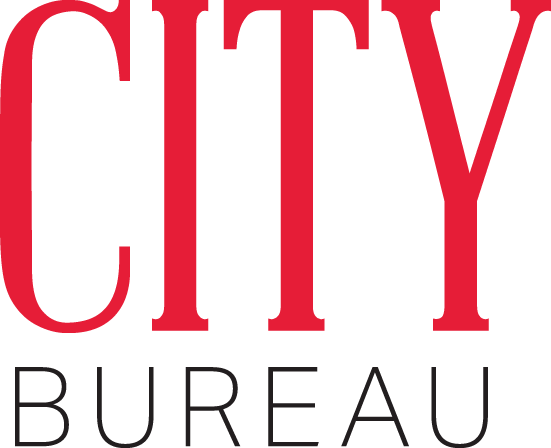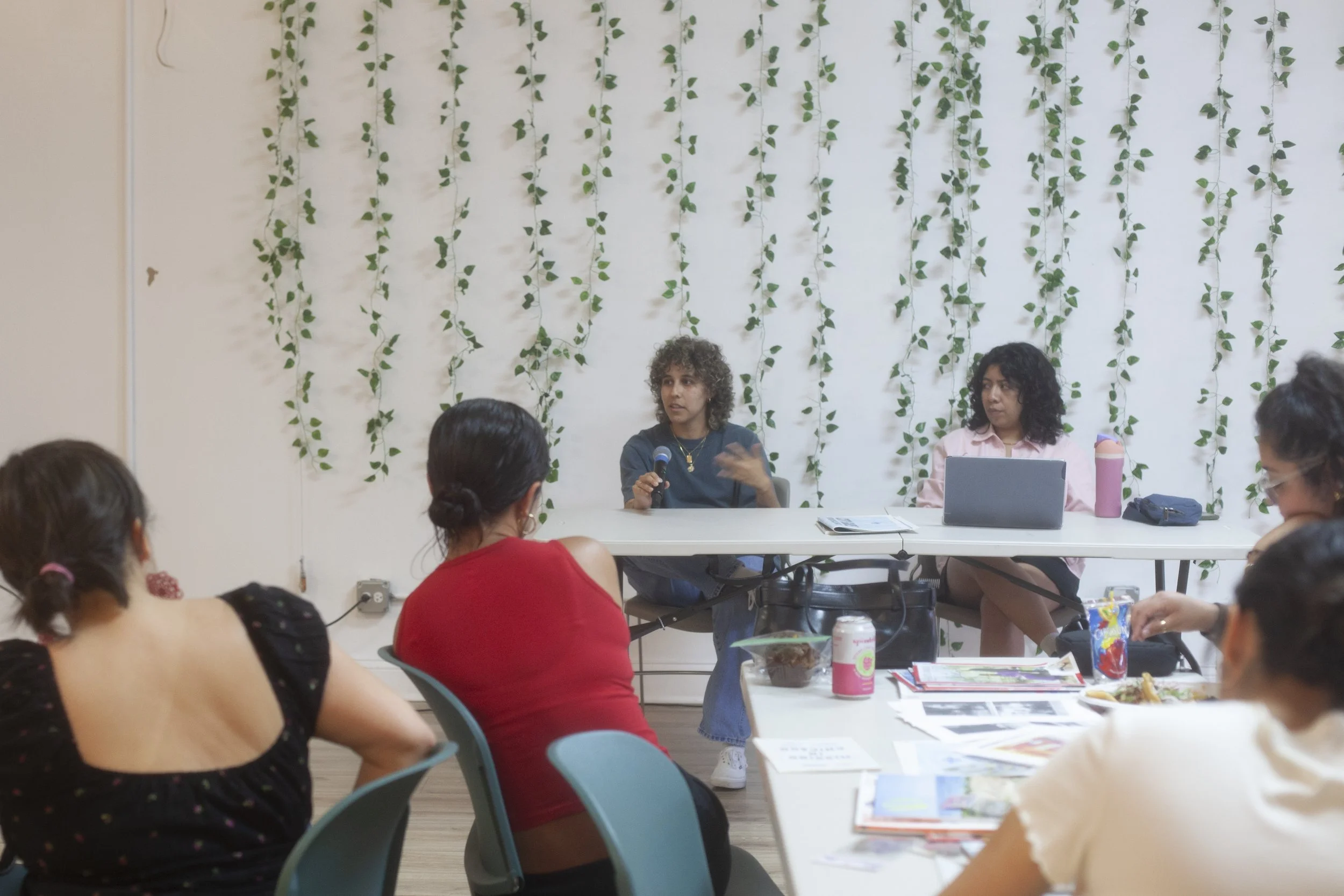Nuestro Chicago Archives is inviting local Latinos to share their old family photos to create deeper histories of their communities over time.
By Erika Perez
Attendees show off their final collage creations from Public Newsroom 158, hosted at 18th Street Casa de Cultura in Chicago on June 26, 2025. (Photo: Samantha Friend Cabrera/City Bureau)
When was the last time you sat with your family and looked through old photos? If you can’t remember, Nuestro Chicago Archives wants you to take a trip back to the past.
City Bureau’s Public Newsroom invited community members to 18th Street Casa de Cultura on June 26. Thais, the founder of Nuestro Chicago Archives, shared the vision behind their project in conversation with Marilyn Carteno, City Bureau’s events and outreach coordinator. Guests then took a hands-on approach to archiving, using personal artifacts and magazine images to create a collage and capsule of their lives.
Photo archiving allows people to document their lives through photos, Thais explained. They launched Nuestro Chicago Archives in 2024, building off a lifelong interest in taking and preserving photos.
On their Instagram account, @nuestro.chicago.archives, Thais asks for submissions, looking for photos capturing specific eras in Chicago history and allowing people to showcase their family histories.
“We have stories; we've been here for a long, long time, whether they want to see us or not, and whether we're disposable or not,” Thais said. “It’s just such a gift to have people share their photos with me and want to share that with the world.”
Here are some other takeaways from the event.
‘It needs to be seen’
With the rise of gentrification and the displacement of Chicago’s Latino communities, preserving the history of those communities became particularly important to Thais, they said.
“It's just definitely been eye-opening. I didn’t know there were Latinos in Uptown, and I'm just like, OK, let’s open that up,” they said. “And it’s just important to share that bit from their story because we have so many stories in Chicago — it needs to be seen.”
Thais (seated left), founder of Nuestro Chicago Archives, and Marilyn Carteno (seated right) of City Bureau host a panel discussion on the importance of visual archives, stories, and preservation in Latine communities, particularly those native to Chicago. (Photo: Samantha Friend Cabrera/City Bureau)
The archive has helped to expose gentrification erasure, and in doing so, Thais has been inspired to dig deeper by looking at maps and doing research about the cultural and social history of a neighborhood.
“I’ll look at a map of the city and start researching Latinos in the area, [and then] make a callout on Instagram so people from that area can submit photos. I want people to feel included,” Thais said.
A participant from the event expressed how the archive is a manifestation of what historic preservation and the landmarking process should be about.
“You have provided the environmental context to these places, that they may be landmarked institutionally, but nobody's talking about who was there before the area became attractive,” they said.
a physical presence in history
Although you can view Nuestro Chicago Archives digitally, the pictures in the collection are physical images taken with film or printed. An archive is meant to encapsulate a moment in time that photos stored on a phone can’t, Thais said.
“Nowadays it's like, OK, my photos are in my cloud. I took the picture; now it's gone. I just uploaded it. And that's that's fine, but I think it's so accessible that we just kind of forget about it,” Thais said.
Anyone can be a part of the archive by submitting a photo that fits an open call from Thais.
The best photos come from collections passed down by family and friends; the ones so old they bring up dialogues about what is happening, they said. For that reason, there are a couple of strict rules: Nothing digital. Thais is looking for family photos, taken around the city and shot before 2008.
“The photos I grew up looking [through] at my grandparents' house, they have a certain feel to it. I just kind of want to cut it off [in 2008], because [after that,] it just looks too new,” Thais said. “I want to document or let you see the places where Latinos existed, even though we aren't there anymore.”
‘The art of archiving’
Archiving requires viewers to be face to face with a photo. You need to get in touch with the backstory of how it got into your hands, Thais said.
“It's just nice to feel it and know that someone, like my mom or my dad, went in the store, bought the film, took pictures and then went to have them developed,” Thais said. “And then taking the time to flip through all those photos in the plastic and all of that — it’s beautiful to me.”
Attendees of City Bureau’s Public Newsroom 158 spend time creating personal photo collages as prompted by a conversation between Thais, the founder of Nuestro Chicago Archives, and Marilyn of City Bureau. (Photo: Samantha Friend Cabrera/City Bureau)
The collaging activity at June’s Public Newsroom did just that. As guests created their own archives, Thais emphasized the preservation of history — the stories happening now and how we think about the stories in the future. Looking through old photos with family and friends sparks conversations that deepen one's knowledge of their histories, they said.
“It’s really nice to see your life through a physical copy. I want to inspire future generations to continue the art of archiving. To see how it’s not just a picture, but how it opens dialogues about the different moments in our lives,” Thais said.
Find Nuestro Chicago Archives on Instagram. For more information on our next Public Newsroom, set for July 31, visit our Eventbrite page.
Support City Bureau’s community-centered engagement work by becoming a recurring donor today.



